How Much Do We Care about Teacher Burnout during the Pandemic: A Bibliometric Review
Abstract
1. Introduction
2. Materials and Methods
2.1. Data Collection
2.2. Bibliometric Analysis
3. Results
3.1. Basic Indicators
3.1.1. Years
3.1.2. Authors
3.1.3. Institutions
3.1.4. Countries
3.1.5. Journals
3.1.6. Most Common Keywords
3.2. Co-Citation Analysis
3.2.1. Co-Authorship
3.2.2. Collaborations between Countries
3.3. Thematic Analysis
3.3.1. Bibliographic Coupling for Documents and Keywords
3.3.2. Strategic Thematic Analysis
4. Discussion
5. Conclusions, Limitations and Implications
Author Contributions
Funding
Institutional Review Board Statement
Data Availability Statement
Acknowledgments
Conflicts of Interest
References
- Martínez, C.N.; Bañón, A.R. Emprendimiento en épocas de crisis: Un análisis exploratorio de los efectos de la COVID-19. Small Bus. Int. Rev. 2020, 4, 53–66. [Google Scholar] [CrossRef]
- Balsalobre, J.P.; Pecharromán, D.P. Coronavirus: Efecto del estado de alarma en la evolución de la epidemia. Previsiones y estimaciones. Bie3 Bol. IEEE 2020, 18, 625–653. Available online: https://dialnet.unirioja.es/servlet/articulo?codigo=7552075 (accessed on 20 January 2021).
- Lizaraso Caparó, F.; Del Carmen Sara, J.C.; Lizaraso Caparó, F.; Del Carmen Sara, J.C. Coronavirus y las amenazas a la salud mundial. Horiz. Méd. Lima 2020, 20, 4–5. [Google Scholar] [CrossRef]
- Kim, L.E.; Asbury, K. ‘Like a rug had been pulled from under you’: The impact of COVID-19 on teachers in England during the first six weeks of the UK lockdown. Br. J. Educ. Psychol. 2020, 90, 1062–1083. [Google Scholar] [CrossRef]
- Dal-Ré, R.; Camps, V. Who should be vaccinated against COVID-19 first? Med. Clin. (Barc.) 2021, 156, 177–179. [Google Scholar] [CrossRef]
- Picazo, J.J. Vacuna frente al COVID-19. Rev. Esp. Quimioter. 2021, 34, 569–598. [Google Scholar] [CrossRef]
- Sheikh, A.; Sheikh, A.; Sheikh, Z.; Dhami, S. Reopening schools after the COVID-19 lockdown. J. Glob. Health 2020, 10, 010376. [Google Scholar] [CrossRef]
- Lancker, W.V.; Parolin, Z. COVID-19, school closures, and child poverty: A social crisis in the making. Lancet Public Health 2020, 5, e243–e244. [Google Scholar] [CrossRef]
- Viner, R.M.; Russell, S.J.; Croker, H.; Packer, J.; Ward, J.; Stansfield, C.; Mytton, O.; Bonell, C.; Booy, R. School closure and management practices during coronavirus outbreaks including COVID-19: A rapid systematic review. Lancet Child Adolesc. Health 2020, 4, 397–404. [Google Scholar] [CrossRef]
- World Bank Education COVID-19 School Closures Map. Available online: https://www.worldbank.org/en/data/interactive/2020/03/24/world-bank-education-and-covid-19 (accessed on 1 March 2022).
- UNESCO. Adverse Consequences of School Closures. 2020. Available online: https://en.unesco.org/covid19/educationresponse/consequences (accessed on 20 December 2020).
- Al Lily, A.E.; Ismail, A.F.; Abunasser, F.M.; Alhajhoj Alqahtani, R.H. Distance education as a response to pandemics: Coronavirus and Arab culture. Technol. Soc. 2020, 63, 101317. [Google Scholar] [CrossRef]
- Besser, A.; Lotem, S.; Zeigler-Hill, V. Psychological Stress and Vocal Symptoms Among University Professors in Israel: Implications of the Shift to Online Synchronous Teaching During the COVID-19 Pandemic. J. Voice 2020, 36, 291.e9–291.e16. [Google Scholar] [CrossRef] [PubMed]
- Bottiani, J.H.; Duran, C.A.K.; Pas, E.T.; Bradshaw, C.P. Teacher stress and burnout in urban middle schools: Associations with job demands, resources, and effective classroom practices. J. Sch. Psychol. 2019, 77, 36–51. [Google Scholar] [CrossRef] [PubMed]
- Shackleton, N.; Bonell, C.; Jamal, F.; Allen, E.; Mathiot, A.; Elbourne, D.; Viner, R. Teacher Burnout and Contextual and Compositional Elements of School Environment. J. Sch. Health 2019, 89, 977–993. [Google Scholar] [CrossRef] [PubMed]
- Karasek, R.A. Job Demands, Job Decision Latitude, and Mental Strain: Implications for Job Redesign. Adm. Sci. Q. 1979, 24, 285–308. [Google Scholar] [CrossRef]
- Siegrist, J. Adverse health effects of high-effort/low-reward conditions. J. Occup. Health Psychol. 1996, 1, 27–41. [Google Scholar] [CrossRef] [PubMed]
- Osifila, G.I.; Abimbola, A.T. Workload and lecturers’ job satisfaction in Adekunle Ajasin University, Akungba-Akoko, Ondo State, Nigeria. J. Educ. Learn. EduLearn 2020, 14, 416–423. [Google Scholar] [CrossRef]
- Xu, Z.; Yang, F. The impact of perceived organizational support on the relationship between job stress and burnout: A mediating or moderating role? Curr. Psychol. 2021, 40, 402–413. [Google Scholar] [CrossRef]
- Shiri, R.; Hiilamo, A.; Rahkonen, O.; Robroek, S.J.W.; Pietiläinen, O.; Lallukka, T. Predictors of working days lost due to sickness absence and disability pension. Int. Arch. Occup. Environ. Health 2021, 94, 843–854. [Google Scholar] [CrossRef]
- Dreison, K.C.; White, D.A.; Bauer, S.M.; Salyers, M.P.; McGuire, A.B. Integrating Self-Determination and Job Demands-Resources Theory in Predicting Mental Health Provider Burnout. Adm. Policy Ment. Health Ment. Health Serv. Res. 2018, 45, 121–130. [Google Scholar] [CrossRef]
- Drüge, M.; Schladitz, S.; Wirtz, M.A.; Schleider, K. Psychosocial Burden and Strains of Pedagogues—Using the Job Demands-Resources Theory to Predict Burnout, Job Satisfaction, General State of Health, and Life Satisfaction. Int. J. Environ. Res. Public Health 2021, 18, 7921. [Google Scholar] [CrossRef]
- Engelbrecht, G.J.; de Beer, L.T.; Schaufeli, W.B. The relationships between work intensity, workaholism, burnout, and self-reported musculoskeletal complaints. Hum. Factors Ergon. Manuf. Serv. Ind. 2020, 30, 59–70. [Google Scholar] [CrossRef]
- Maslach, C.; Schaufeli, W.B.; Leiter, M.P. Job Burnout. Annu. Rev. Psychol. 2001, 52, 397–422. [Google Scholar] [CrossRef] [PubMed]
- McCarty, W.P.; Aldirawi, H.; Dewald, S.; Palacios, M. Burnout in Blue: An Analysis of the Extent and Primary Predictors of Burnout Among Law Enforcement Officers in the United States. Police Q. 2019, 22, 278–304. [Google Scholar] [CrossRef]
- Maslach, C.; Goldberg, J. Prevention of burnout: New perspectives. Appl. Prev. Psychol. 1998, 7, 63–74. [Google Scholar] [CrossRef]
- Mojica-Crespo, R.; Morales-Crespo, M.M. Pandemia COVID-19, la nueva emergencia sanitaria de preocupación internacional: Una revisión. Med. Fam. SEMERGEN 2020, 46, 65–77. [Google Scholar] [CrossRef]
- Cifuentes-Faura, J. Crisis del coronavirus: Impacto y medidas económicas en Europa y en el mundo. Occup. Med. 2020. [Google Scholar] [CrossRef]
- Gil-Monte, P. Manual de Psicosociología Aplicada al Trabajo y a la Prevención de los Riesgos Laborales; Pirámide: Madrid, Spain, 2014; ISBN 978-84-368-3144-3. [Google Scholar]
- Stanton, R.; To, Q.G.; Khalesi, S.; Williams, S.L.; Alley, S.J.; Thwaite, T.L.; Fenning, A.S.; Vandelanotte, C. Depression, Anxiety and Stress during COVID-19: Associations with Changes in Physical Activity, Sleep, Tobacco and Alcohol Use in Australian Adults. Int. J. Environ. Res. Public Health 2020, 17, 4065. [Google Scholar] [CrossRef]
- Bosma, H.; Peter, R.; Siegrist, J.; Marmot, M. Two alternative job stress models and the risk of coronary heart disease. Am. J. Public Health 1998, 88, 68–74. [Google Scholar] [CrossRef]
- Guglielmi, R.S.; Tatrow, K. Occupational Stress, Burnout, and Health in Teachers: A Methodological and Theoretical Analysis. Rev. Educ. Res. 1998, 68, 61–99. [Google Scholar] [CrossRef]
- Belkić, K.; Schnall, P.; Landsbergis, P.; Baker, D. The workplace and cardiovascular health: Conclusions and thoughts for a future agenda. Occup. Med. Phila. Pa 2000, 15, 307–321. [Google Scholar]
- Stansfield, S.; Marmot, M. Work Related Factors and Ill Health: The Whitehall II Study; HSE Books: Sudbury, ON, Canada, 2000. [Google Scholar]
- Beswick, K. Changes in Preservice Teachers’ Attitudes and Beliefs: The Net Impact of Two Mathematics Education Units and Intervening Experiences. Sch. Sci. Math. 2006, 106, 36–47. [Google Scholar] [CrossRef]
- Sobeih, T.M.; Salem, O.; Daraiseh, N.; Genaidy, A.; Shell, R. Psychosocial factors and musculoskeletal disorders in the construction industry: A systematic review. Theor. Issues Ergon. Sci. 2006, 7, 329–344. [Google Scholar] [CrossRef]
- Stansfeld, S.; Candy, B. Psychosocial work environment and mental health—A meta-analytic review. Scand. J. Work. Environ. Health 2006, 32, 443–462. [Google Scholar] [CrossRef] [PubMed]
- Cohen, S.; Janicki-Deverts, D. Who’s Stressed? Distributions of Psychological Stress in the United States in Probability Samples from 1983, 2006, and 2009. J. Appl. Soc. Psychol. 2012, 42, 1320–1334. [Google Scholar] [CrossRef]
- López-Araújo, B.; Segovia, A.O. Influencia de algunas variables organizacionales sobre la salud y la accidentabilidad laboral. An. Psicol. Ann. Psychol. 2010, 26, 89–94. [Google Scholar]
- Méndez Venegas, J. Estrés laboral o síndrome de “burnout”. Acta Pediátr. México 2019, 255, 299–302. [Google Scholar]
- de Mendoza Urrizola, J.H. Absentismo asociado al síndrome de burnout. Coste económico del estrés laboral asistencial en un hospital. Mapfre Med. 2004, 15, 193–198. [Google Scholar]
- Hadar, L.L.; Ergas, O.; Alpert, B.; Ariav, T. Rethinking teacher education in a VUCA world: Student teachers’ social-emotional competencies during the Covid-19 crisis. Eur. J. Teach. Educ. 2020, 43, 573–586. [Google Scholar] [CrossRef]
- Bardera Mora, P.; Osca Segocia, A.; González Camino López, G. Influencia del estrés y la satisfacción laboral sobre la propensión al abandono de la organización, el absentismo la accidentalidad. Ansiedad Estrés 2002, 8, 275–284. [Google Scholar]
- Mejía Córdova, G. Pérdida de productividad en el lugar de trabajo relacionada con el estrés financiero. J. Behav. Health Soc. Issues 2016, 8, 25–34. [Google Scholar] [CrossRef]
- Lipp, M.E.N.; Costa, K.R.D.S.N.; Nunes, V.D.O. Estrés y calidad de vida, estresores ocupacionales de policías: Los síntomas más comunes. Rev. Psicol. Organ. E Trab. 2017, 17, 46–53. [Google Scholar] [CrossRef]
- Atalaya, P.M. El estrés laboral y su influencia en el trabajo. Ind. Data 2014, 4, 25–36. [Google Scholar] [CrossRef][Green Version]
- Durán, M.M. Bienestar psicológico: El estrés y la calidad de vida en el contexto laboral. Rev. Nac. Adm. 2010, 1, 71–84. [Google Scholar] [CrossRef]
- Kaur, B.; Singh, A. Burnout among School Teachers in Relation to Their Psychological Well-Being—ProQuest. Available online: https://www.proquest.com/openview/6958a840d9ae0beac23795ec52e324a6/1?pq-origsite=gscholar&cbl=2032134 (accessed on 10 April 2022).
- Schonfeld, I.S.; Verkuilen, J.; Bianchi, R. Inquiry into the correlation between burnout and depression. J. Occup. Health Psychol. 2019, 24, 603–616. [Google Scholar] [CrossRef] [PubMed]
- Yerdelen, S.; Sungur, S.; Klassen, R.M. Türkiye’deki Fen Bilgisi Öğretmenlerinin Mesleki İyilik Durumlarının Bazı Demografik ve Kontekst Değişkenleri ile İlişkisi: Çok Değişkenli Analiz. Educ. Sci. 2016, 41, 147–161. [Google Scholar] [CrossRef]
- Travers, C. Current Knowledge on the Nature, Prevalence, Sources and Potential Impact of Teacher Stress. In Educator Stress. Aligning Perspectives on Health, Safety and Well-Being; McIntyre, T., McIntyre, S., Francis, D., Eds.; Springer: Cham, Switzerland, 2017; pp. 23–54. [Google Scholar] [CrossRef]
- McLean, L.; Taylor, M.; Jimenez, M. Career choice motivations in teacher training as predictors of burnout and career optimism in the first year of teaching. Teach. Teach. Educ. 2019, 85, 204–214. [Google Scholar] [CrossRef]
- Jennings, P.A.; Greenberg, M.T. The Prosocial Classroom: Teacher Social and Emotional Competence in Relation to Student and Classroom Outcomes. Rev. Educ. Res. 2009, 79, 491–525. [Google Scholar] [CrossRef]
- Zapf, D.; Vogt, C.; Seifert, C.; Mertini, H.; Isic, A. Emotion work as a source of stress: The concept and development of an instrument. Eur. J. Work. Organ. Psychol. 1999, 8, 371–400. [Google Scholar] [CrossRef]
- Makhdoom, I.F.; Atta, M.; Malik, N.I. Counterproductive Work Behaviors as an Outcome of Job Burnout among High School Teachers. Bull. Educ. Res. 2019, 41, 79–92. [Google Scholar]
- Martínez-Monteagudo, M.C.; Inglés, C.J.; Granados, L.; Aparisi, D.; García-Fernández, J.M. Trait emotional intelligence profiles, burnout, anxiety, depression, and stress in secondary education teachers. Personal. Individ. Differ. 2019, 142, 53–61. [Google Scholar] [CrossRef]
- Gómez, R.A.F.; Valle, C.M.Z. Impacto psicológico en los docentes de educación primaria a causa de la COVID-19. Acad. Rev. Investig. En Cienc. Soc. Y Humanid. 2021, 8, 129–139. [Google Scholar]
- Workers Want to Telework but Long Working Hours, Isolation and Inadequate Equipment Must be Tackled. Available online: https://www.eurofound.europa.eu/es/publications/article/2021/workers-want-to-telework-but-long-working-hours-isolation-and-inadequate-equipment-must-be-tackled (accessed on 5 April 2022).
- Ribeiro, B.M.D.S.S.; Scorsolini-Comin, F.; Dalri, R.D.C.D.M.B. Ser docente en el contexto de la pandemia de COVID-19: Reflexiones sobre la salud mental. Index Enferm. 2020, 29, 137–141. [Google Scholar]
- Çiçek Korkmaz, A.; Altuntaş, S. A bibliometric analysis of COVID-19 publications in nursing by visual mapping method. J. Nurs. Manag. 2022. [Google Scholar] [CrossRef] [PubMed]
- Crocerossa, F.; Visser, W.; Carbonara, U.; Falagario, U.G.; Pandolfo, S.D.; Loizzo, D.; Imbimbo, C.; Klausner, A.P.; Porpiglia, F.; Damiano, R.; et al. The impact the COVID-19 pandemic on urology literature: A bibliometric analysis. Cent. Eur. J. Urol. 2022, 75, 102–109. [Google Scholar] [CrossRef]
- Vasantha Raju, N.; Patil, S.B. Indian Publications on SARS-CoV-2: A bibliometric study of WHO COVID-19 database. Diabetes Metab. Syndr. 2020, 14, 1171–1178. [Google Scholar] [CrossRef]
- Al-Jabi, S.W. Current global research landscape on COVID-19 and depressive disorders: Bibliometric and visualization analysis. World J. Psychiatry 2021, 11, 253–264. [Google Scholar] [CrossRef]
- Greve, K.; Leminen, S.; De Vita, R.; Westerlund, M. Unveiling the diversity of scholarly debate on living labs: A bibliometric approach. Int. J. Innov. Manag. 2020, 24, 2040003. [Google Scholar] [CrossRef]
- Anholon, R.; Rampasso, I.S.; Dibbern, T.; Serafim, M.P.; Filho, W.L.; Quelhas, O.L.G. COVID-19 and decent work: A bibliometric analysis. Work 2022, 71, 833–841. [Google Scholar] [CrossRef]
- Pajić, D. COVID-19 citation pandemic within the psychological knowledge domain. Curr. Psychol. 2022, 1–15. [Google Scholar] [CrossRef]
- Liu, T.; Liu, X.; Li, Y.; Liu, S.; Cao, C. Evolving Trends and Research Hotspots in Disaster Epidemiology From 1985 to 2020: A Bibliometric Analysis. Front. Public Health 2021, 9, 720787. [Google Scholar] [CrossRef]
- Cao, Q.-T.; Vuong, Q.-H.; Pham, H.-H.; Luong, H.; Ho, T.; Hoang, A.-D.; Trang, D. A Bibliometric Review of Research on International Students’ Mental Health: Science Mapping of the Literature from 1957 to 2020. Eur. J. Investig. Health Psychol. Educ. 2021, 11, 781–794. [Google Scholar] [CrossRef] [PubMed]
- Mobin, M.A.; Mahi, M.; Hassan, M.K.; Habib, M.; Akter, S.; Hassan, T. An analysis of COVID-19 and WHO global research roadmap: Knowledge mapping and future research agenda. Eurasian Econ. Rev. 2021. [Google Scholar] [CrossRef]
- Zambrano, D.; Serrato Alvarez, D.; Galindo Caballero, O.J.; Zambrano, D.; Serrato Alvarez, D.; Galindo Caballero, O.J. Publications in Psychology Related to the COVID-19: A Bibliometric Analysis. Psicol. Desde El Caribe 2021, 38, 11–28. [Google Scholar] [CrossRef]
- Navarro-Espinosa, J.A.; Vaquero-Abellán, M.; Perea-Moreno, A.-J.; Pedrós-Pérez, G.; Aparicio-Martínez, P.; Martínez-Jiménez, M.P. The Influence of Technology on Mental Well-Being of STEM Teachers at University Level: COVID-19 as a Stressor. Int. J. Environ. Res. Public Health 2021, 18, 9605. [Google Scholar] [CrossRef] [PubMed]
- Liu, Z.; Yang, Z.; Xiao, C.; Zhang, K.; Osmani, M. An Investigation into Art Therapy Aided Health and Well-Being Research: A 75-Year Bibliometric Analysis. Int. J. Environ. Res. Public Health 2021, 19, 232. [Google Scholar] [CrossRef] [PubMed]
- Bibliometric Analysis on Global Research Trends of Airborne Microorganisms in Recent Ten Years (2011–2020)—Aerosol and Air Quality Research. Available online: https://aaqr.org/articles/aaqr-20-07-oa-0497 (accessed on 30 May 2022).
- Poszytek, P. Relational and Networking Character: Threat or Savior for the Sustainability of European Erasmus+ Projects in the Times of COVID-19 Pandemic? Sustainability 2021, 13, 9338. [Google Scholar] [CrossRef]
- Brown, M.A.; Soni, A.; Doshi, A.D.; King, C. The persistence of high energy burdens: A bibliometric analysis of vulnerability, poverty, and exclusion in the United States. Energy Res. Soc. Sci. 2020, 70, 101756. [Google Scholar] [CrossRef]
- You, Y.; Shou, X.; Zhang, X.; Fan, S.; Chai, R.; Xue, W.; Hu, Y.; He, Q. Psycho-Cardiological Disease: A Bibliometric Review From 2001 to 2021. Front. Cardiovasc. Med. 2022, 9, 890329. [Google Scholar] [CrossRef]
- Lim, H.; Suh, C.-K. Visualizing the Intellectual Structure of the Impact of COVID-19 on E-learning. J. Internet Electron. Commer. Res. 2022, 22, 35–50. [Google Scholar] [CrossRef]
- Gao, Y.; Wong, S.L.; Md Khambari, M.N.; Noordin, N. A bibliometric analysis of online faculty professional development in higher education. Res. Pract. Technol. Enhanc. Learn. 2022, 17, 17. [Google Scholar] [CrossRef]
- Sweileh, W.M. Global Research Activity on E-Learning in Health Sciences Education: A Bibliometric Analysis. Med. Sci. Educ. 2021, 31, 765–775. [Google Scholar] [CrossRef] [PubMed]
- Yan, Y.; Chen, H. Developments and Emerging Trends of Blended Learning A Document Co-citation Analysis (2003–2020). Int. J. Emerg. Technol. Learn. 2021, 16, 149–164. [Google Scholar] [CrossRef]
- Martín, M.C.; González, L.R.; Marchena, J.A.M.; Sanchiz, D.C. Teacher burnout: A bibliometric analysis of scientific production indexed on Scopus. IJERI Int. J. Educ. Res. Innov. 2020, 14, 197–210. [Google Scholar] [CrossRef]
- van Nunen, K.; Li, J.; Reniers, G.; Ponnet, K. Bibliometric analysis of safety culture research. Saf. Sci. 2018, 108, 248–258. [Google Scholar] [CrossRef]
- Clasificación de la Variante Ómicron (B.1.1.529) del SARS-CoV-2como Variante Preocupante. Available online: https://www.who.int/es/news/item/26-11-2021-classification-of-omicron-(b.1.1.529)-sars-cov-2-variant-of-concern (accessed on 11 April 2022).
- Pastor, A. Ómicron en España: Seis datos desde el primer contagio. Newtral. 2022. Available online: https://www.newtral.es/omicron-uci-datos-contagios-hospitalizaciones-variante-espana/20220102/ (accessed on 5 March 2022).
- Moher, D.; Liberati, A.; Tetzlaff, J.M.; Altman, D.G. Preferred Reporting Items for Systematic Reviews and Meta-Analyses: The PRISMA Statement. Annals of Internal Medicine. Ann. Intern. Med. 2009. [Google Scholar] [CrossRef]
- Page, M.J.; McKenzie, J.E.; Bossuyt, P.M.; Boutron, I.; Hoffmann, T.C.; Mulrow, C.D.; Shamseer, L.; Tetzlaff, J.M.; Akl, E.A.; Brennan, S.E.; et al. The PRISMA 2020 statement: An updated guideline for reporting systematic reviews. BMJ 2021, 372, n71. [Google Scholar] [CrossRef]
- Burgos Angulo, D.J.; Rendón Lainez, V.M.; Díaz Nivela, C. de L.; Aguirre Chiriguayo, J.T.; Peralta Zuñiga, G.A.; Angulo de León, T.A. La relajación y estrés laboral en el personal docente: Una revisión sistemática. Lect. Educ. Fís. Deport. 2020, 25, 109–123. [Google Scholar] [CrossRef]
- Palma, A.; Ansoleaga, E.; Ahumada, M.; Palma, A.; Ansoleaga, E.; Ahumada, M. Workplace violence among health care workers: A systematic review. Rev. Méd. Chile 2018, 146, 213–222. [Google Scholar] [CrossRef]
- Gajardo Espinoza, K.; Díez Gutiérrez, E.-J.; Gajardo Espinoza, K.; Díez Gutiérrez, E.-J. Educational evaluation during the COVID-19 crisis: An urgent systematic review. Estud. Pedag. Valdivia 2021, 47, 319–338. [Google Scholar] [CrossRef]
- Jensen, P.; Rouquier, J.-B.; Croissant, Y. Testing bibliometric indicators by their prediction of scientists promotions. Scientometrics 2008, 78, 467–479. [Google Scholar] [CrossRef]
- Giménez-Espert, M.D.C.; Prado-Gascó, V.J. Bibliometric analysis of six nursing journals from the Web of Science, 2012–2017. J. Adv. Nurs. 2019, 75, 543–554. [Google Scholar] [CrossRef] [PubMed]
- Padrón, M.C.D.; Pirela, G. Herramienta de software para el análisis bibliométrico y de redes de producción científica. Rev. CODICES 2017, 13, 18. [Google Scholar]
- Van Eck, N.J.; Waltman, L. Citation-based clustering of publications using CitNetExplorer and VOSviewer. Scientometrics 2017, 111, 1053–1070. [Google Scholar] [CrossRef] [PubMed]
- Aria, M.; Cuccurullo, C. Bibliometrix: An R-tool for comprehensive science mapping analysis. J. Informetr. 2017, 11, 959–975. [Google Scholar] [CrossRef]
- Derviş, H. Bibliometric Analysis using Bibliometrix an R Package. J. Scientometr. Res. 2019, 8, 156–160. [Google Scholar] [CrossRef]
- Journal Impact Factor List 2021—JCR, Web Of Science (PDF, XLS). Available online: https://impactfactorforjournal.com/jcr-2021/ (accessed on 11 April 2022).
- MacIntyre, P.D.; Gregersen, T.; Mercer, S. Language teachers’ coping strategies during the COVID-19 conversion to online teaching: Correlations with stress, wellbeing and negative emotions. System 2020, 94, 102352. [Google Scholar] [CrossRef]
- Matiz, A.; Fabbro, F.; Paschetto, A.; Cantone, D.; Paolone, A.R.; Crescentini, C. Positive Impact of Mindfulness Meditation on Mental Health of Female Teachers during the COVID-19 Outbreak in Italy. Int. J. Environ. Res. Public Health 2020, 17, 6450. [Google Scholar] [CrossRef]
- Panisoara, I.O.; Lazar, I.; Panisoara, G.; Chirca, R.; Ursu, A.S. Motivation and Continuance Intention towards Online Instruction among Teachers during the COVID-19 Pandemic: The Mediating Effect of Burnout and Technostress. Int. J. Environ. Res. Public Health 2020, 17, 8002. [Google Scholar] [CrossRef]
- Zhou, X.; Yao, B. Social support and acute stress symptoms (ASSs) during the COVID-19 outbreak: Deciphering the roles of psychological needs and sense of control. Eur. J. Psychotraumatol. 2020, 11, 1779494. [Google Scholar] [CrossRef]
- Penado Abilleira, M.; Rodicio-García, M.-L.; Ríos-de Deus, M.P.; Mosquera-González, M.J. Technostress in Spanish University Teachers During the COVID-19 Pandemic. Front. Psychol. 2021, 12, 496. [Google Scholar] [CrossRef]
- Sharma, D.; Bhaskar, S. Addressing the COVID-19 Burden on Medical Education and Training: The Role of Telemedicine and Tele-Education During and Beyond the Pandemic. Front. Public Health 2020, 8, 838. [Google Scholar] [CrossRef] [PubMed]
- Lizana, P.A.; Vega-Fernadez, G.; Gomez-Bruton, A.; Leyton, B.; Lera, L. Impact of the COVID-19 Pandemic on Teacher Quality of Life: A Longitudinal Study from before and during the Health Crisis. Int. J. Environ. Res. Public Health 2021, 18, 3764. [Google Scholar] [CrossRef] [PubMed]
- Anderson, R.C.; Bousselot, T.; Katz-Buoincontro, J.; Todd, J. Generating Buoyancy in a Sea of Uncertainty: Teachers Creativity and Well-Being During the COVID-19 Pandemic. Front. Psychol. 2021, 11, 3931. [Google Scholar] [CrossRef] [PubMed]
- Zadok-Gurman, T.; Jakobovich, R.; Dvash, E.; Zafrani, K.; Rolnik, B.; Ganz, A.B.; Lev-Ari, S. Effect of Inquiry-Based Stress Reduction (IBSR) Intervention on Well-Being, Resilience and Burnout of Teachers during the COVID-19 Pandemic. Int. J. Environ. Res. Public Health 2021, 18, 3689. [Google Scholar] [CrossRef] [PubMed]
- Pfefferbaum, M.D.; North, M.D. Mental Health and the Covid-19 Pandemic NEJM. Ner Engl. J. Med. 2020, 383, 510–512. [Google Scholar] [CrossRef] [PubMed]
- Li, L.; Wang, X. Technostress inhibitors and creators and their impacts on university teachers’ work performance in higher education. Cogn. Technol. Work 2021, 23, 315–330. [Google Scholar] [CrossRef]
- Özgür, H. Relationships between teachers’ technostress, technological pedagogical content knowledge (TPACK), school support and demographic variables: A structural equation modeling. Comput. Hum. Behav. 2020, 112, 106468. [Google Scholar] [CrossRef]
- Buelvas, L.V.; Villareal, J.M.; Gomez, H.M.; Palacio, A.T. Gráficos comparativos entre países de las personas contagiadas por COVID-19. Bol. Innov. Logíst. Oper. 2020, 2, 38–43. [Google Scholar] [CrossRef]
- Prado-Gascó, V.; Gómez-Domínguez, M.T.; Soto-Rubio, A.; Díaz-Rodríguez, L.; Navarro-Mateu, D. Stay at Home and Teach: A Comparative Study of Psychosocial Risks Between Spain and Mexico During the Pandemic. Front. Psychol. 2020, 11, 2576. [Google Scholar] [CrossRef]
- Ozamiz-Etxebarria, N.; Berasategi Santxo, N.; Idoiaga Mondragon, N.; Dosil Santamaría, M. The Psychological State of Teachers During the COVID-19 Crisis: The Challenge of Returning to Face-to-Face Teaching. Front. Psychol. 2021, 11, 3861. [Google Scholar] [CrossRef]
- Pérez, V.M.-O. Estrés y ansiedad en los docentes. PULSO Rev. Educ. 2003, 26, 9–21. Available online: https://revistas.cardenalcisneros.es/index.php/PULSO/article/view/35 (accessed on 1 March 2021).
- Moreno, L.L.; García, J.M.; Valdehita, S.R.; Ramiro, E.M.D. Factores psicosociales en el entorno laboral, estrés y enfermedad. Edupsykhé Rev. Psicol. Educ. 2004, 3, 95–108. [Google Scholar]
- Graves, L.M.; Karabayeva, A. Managing Virtual Workers—Strategies for Success. IEEE Eng. Manag. Rev. 2020, 48, 166–172. [Google Scholar] [CrossRef]
- Tarafdar, M.; Tu, Q.; Ragu-Nathan, T.S. Impact of Technostress on End-User Satisfaction and Performance. J. Manag. Inf. Syst. 2010, 27, 303–334. [Google Scholar] [CrossRef]
- Cheng, L. The Implications of EFL/ESL Teachers’ Emotions in Their Professional Identity Development. Front. Psychol. 2021, 12, 755592. [Google Scholar] [CrossRef]
- Mejía, J.C.; Silva, C.A.; Rueda, Y.M. Ruta de atención psicosocial para docentes con síndrome de burnout a causa de la cuarentena generada por el COVID-19. Rev. Investig. Gest. Ind. Ambient. Segur. Salud Trab.-GISST 2020, 2, 133–142. [Google Scholar] [CrossRef]
- Tu, Q.; Wang, K.; Shu, Q. Computer-related technostress in China. Commun. ACM 2005, 48, 77–81. [Google Scholar] [CrossRef]
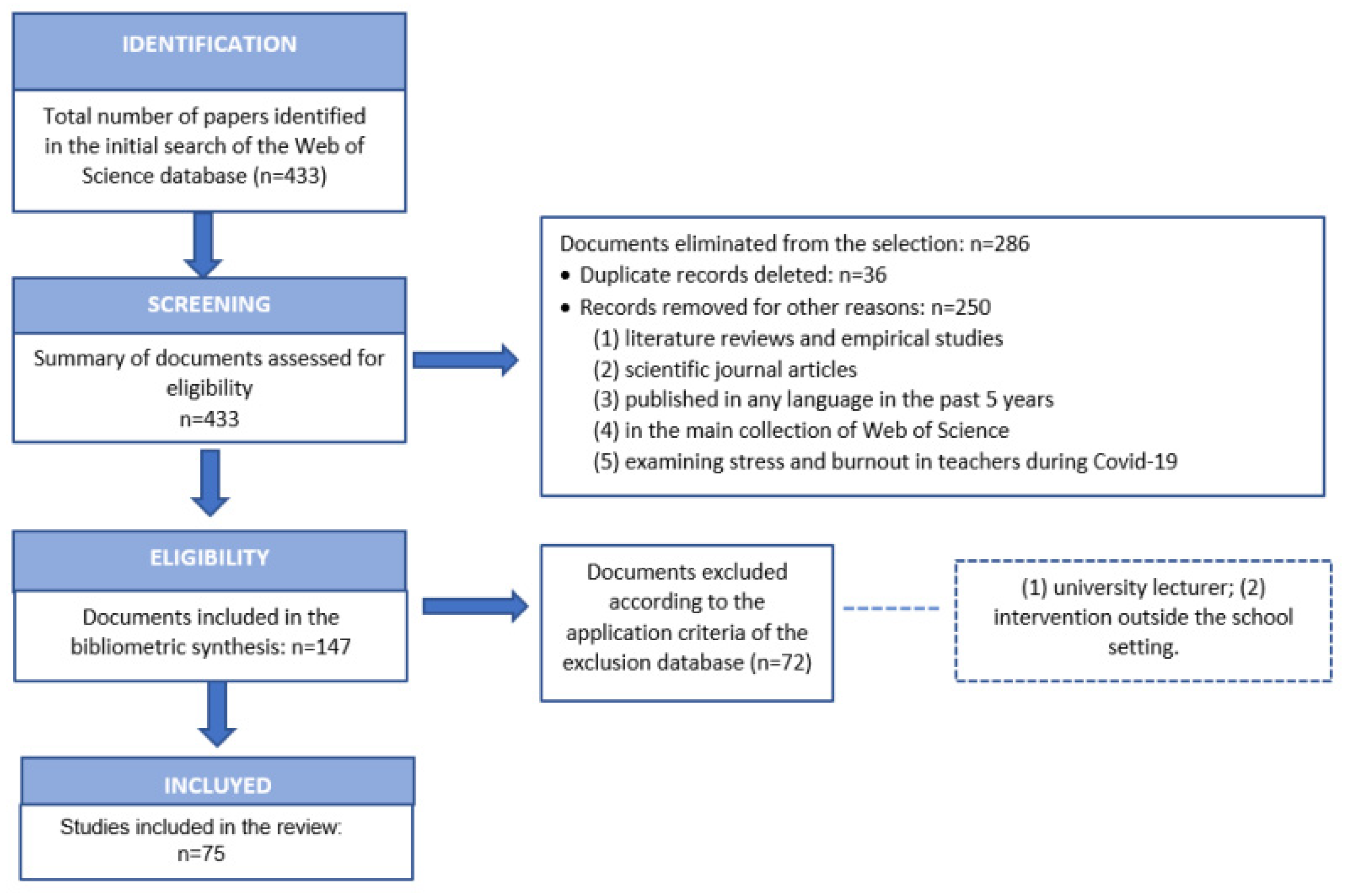


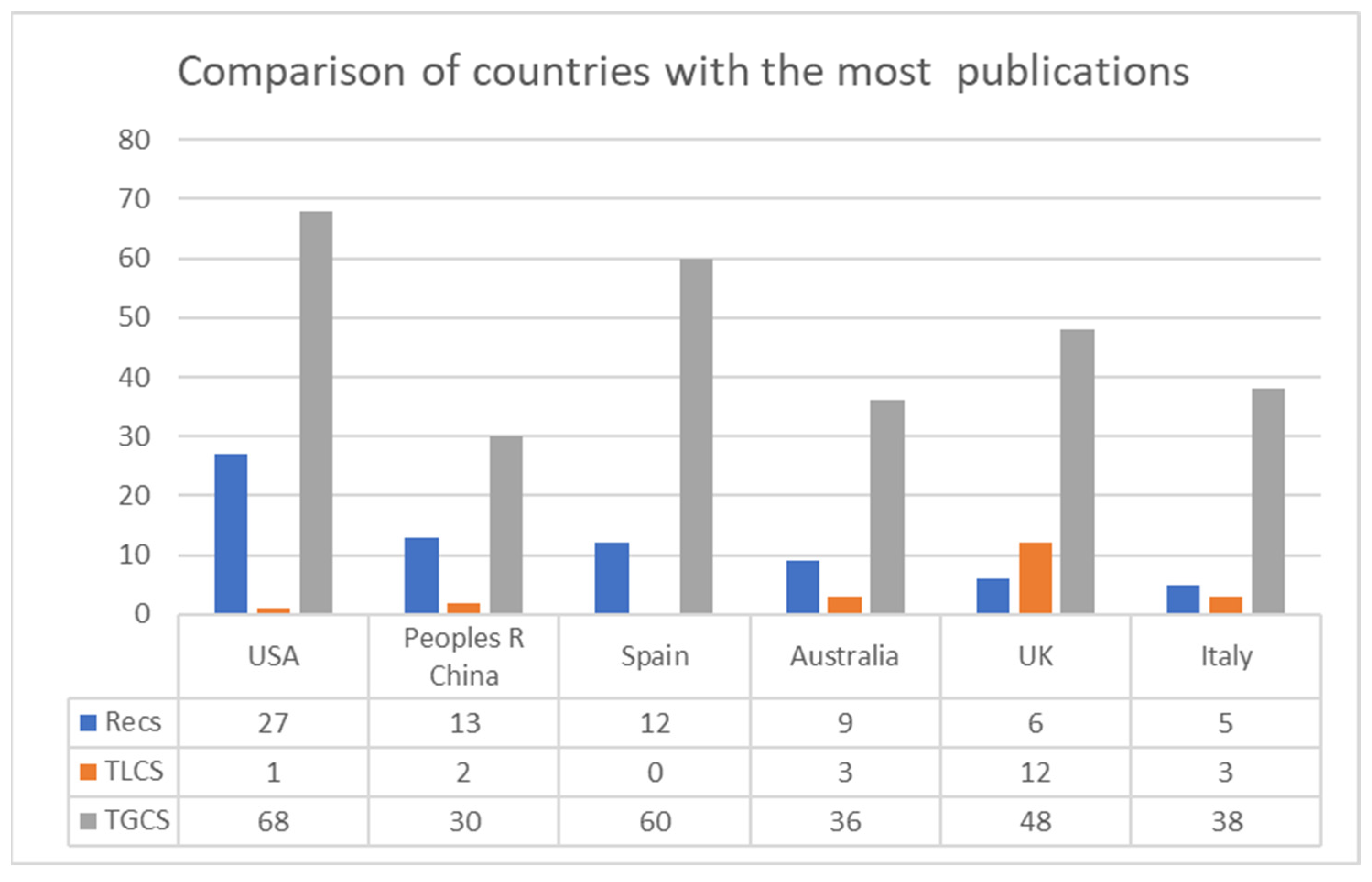


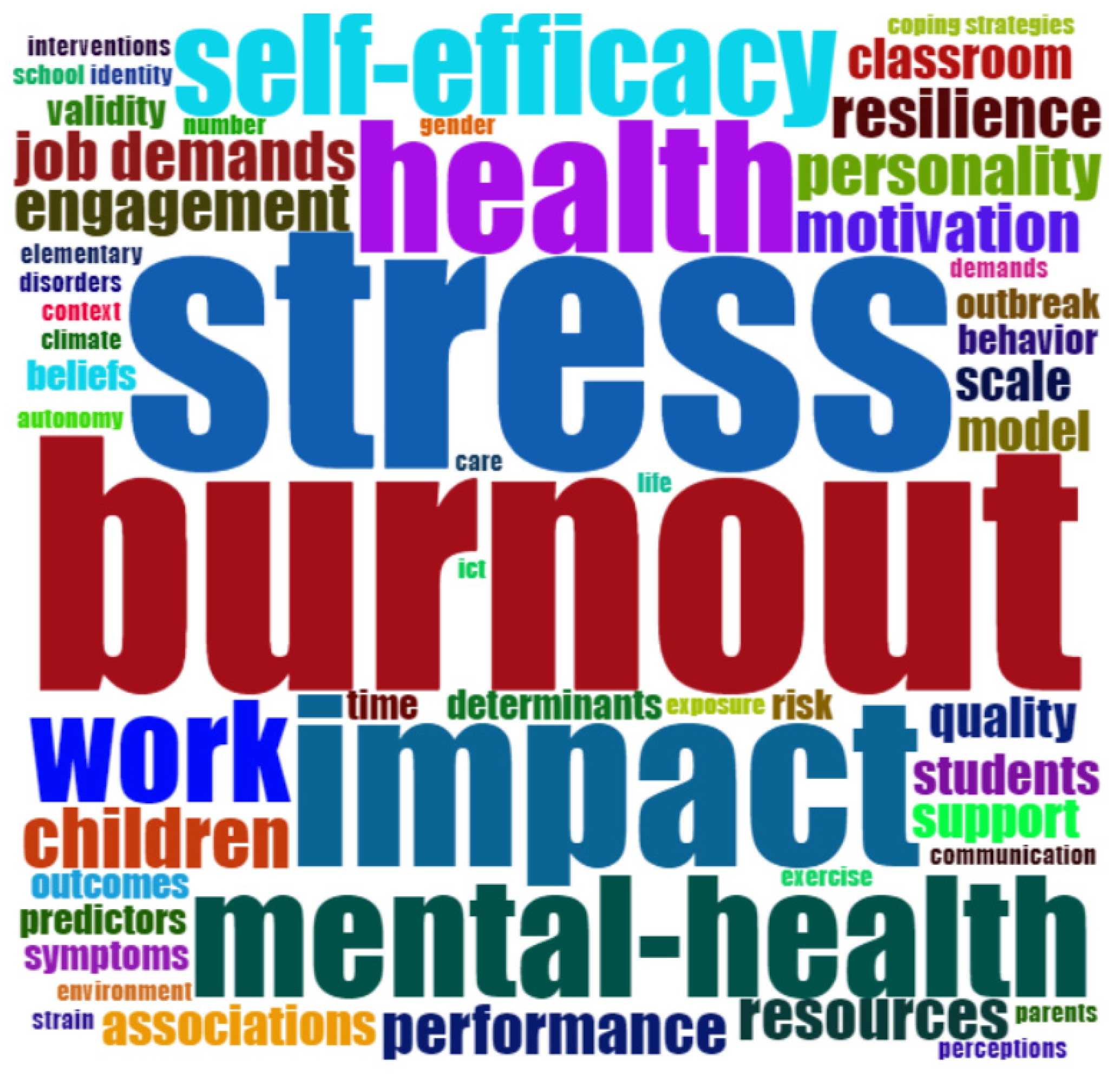
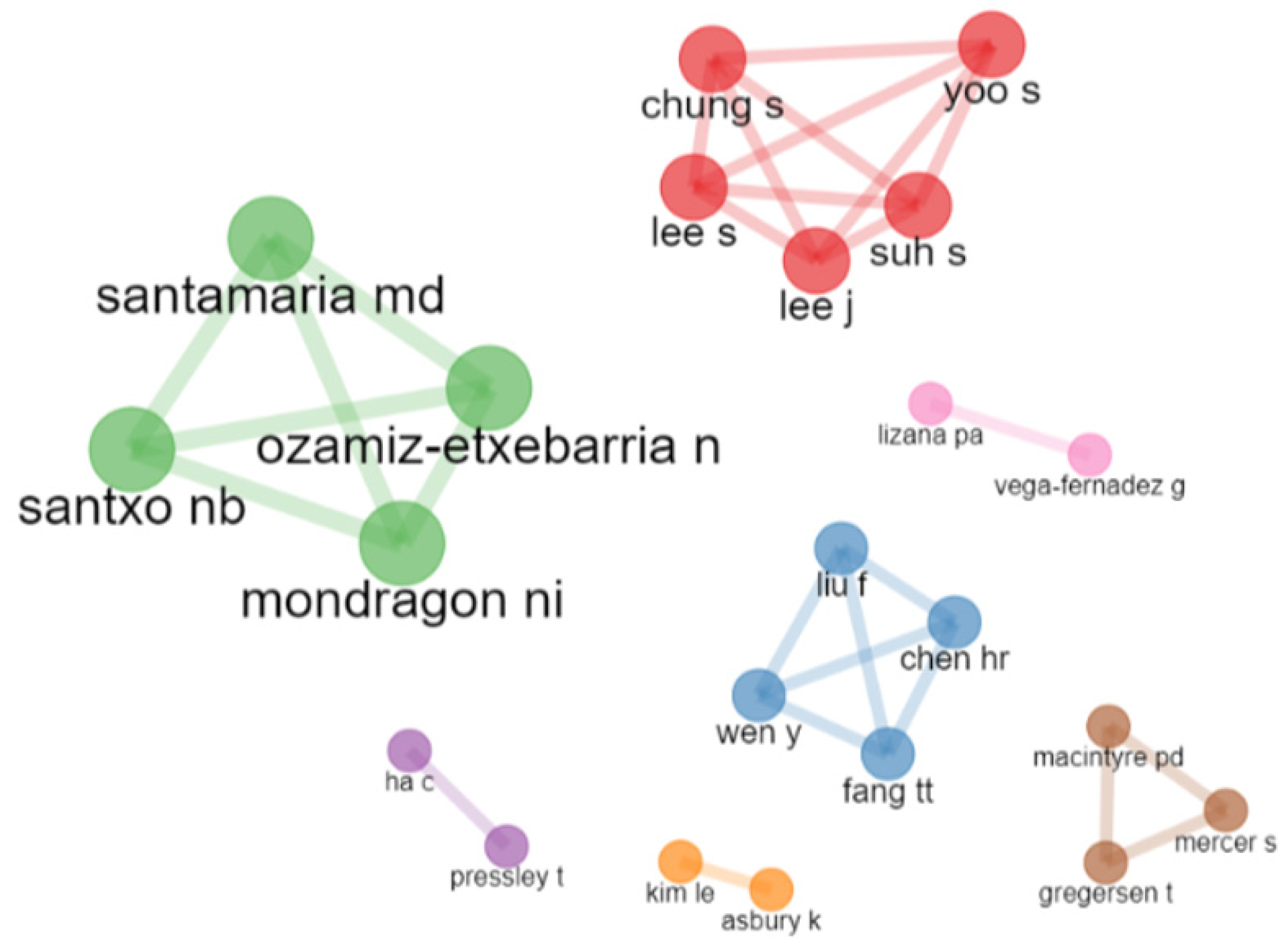
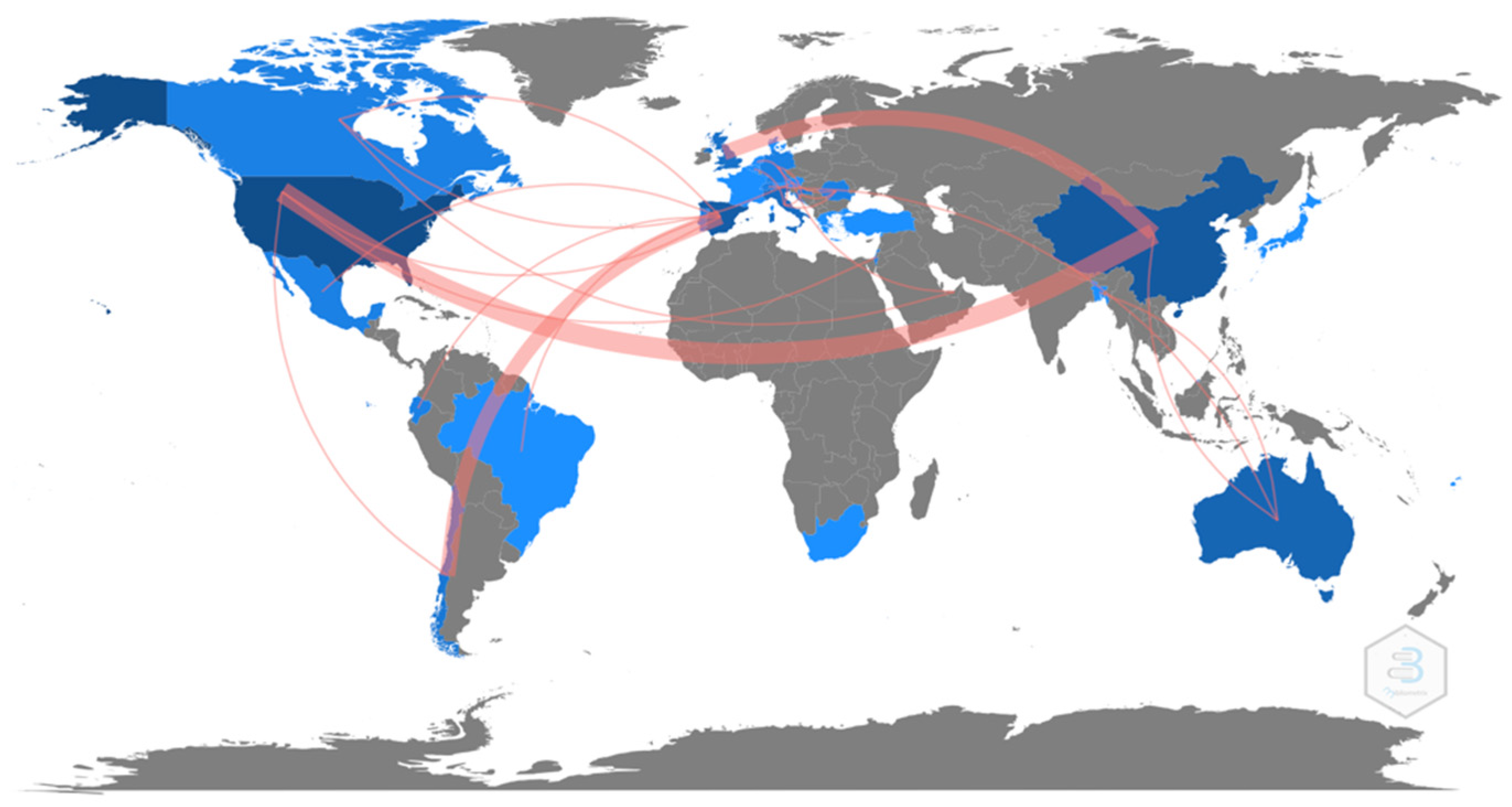

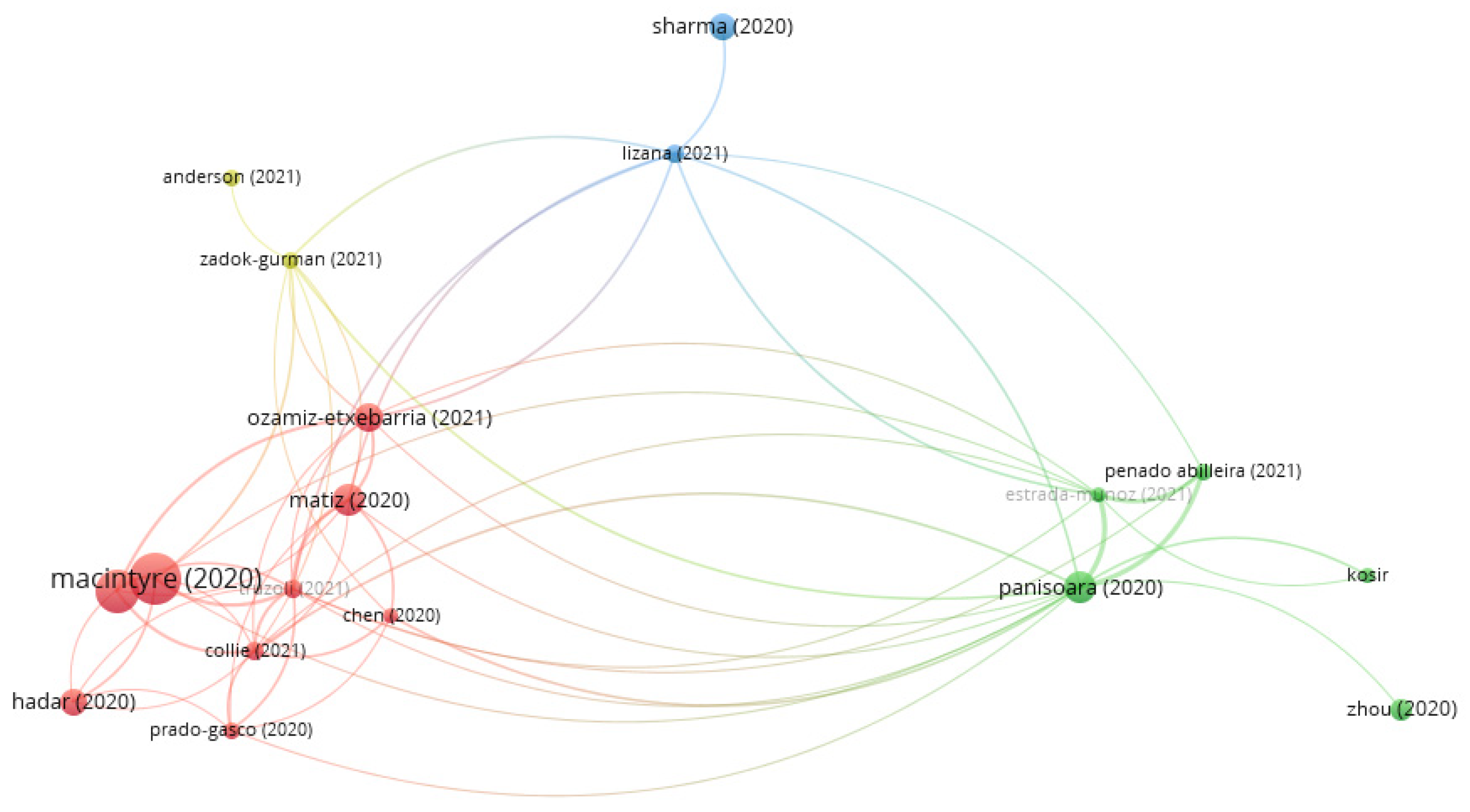
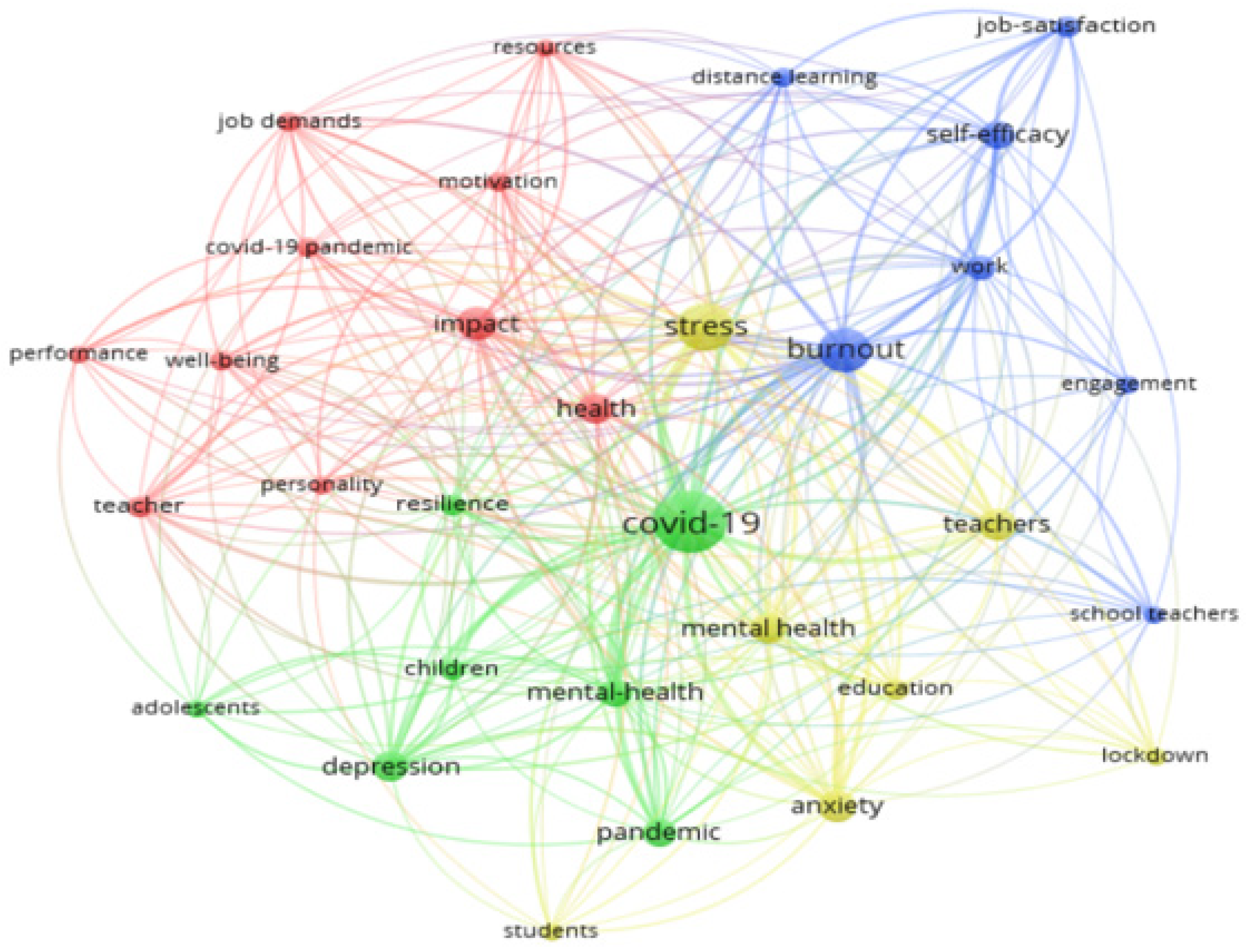
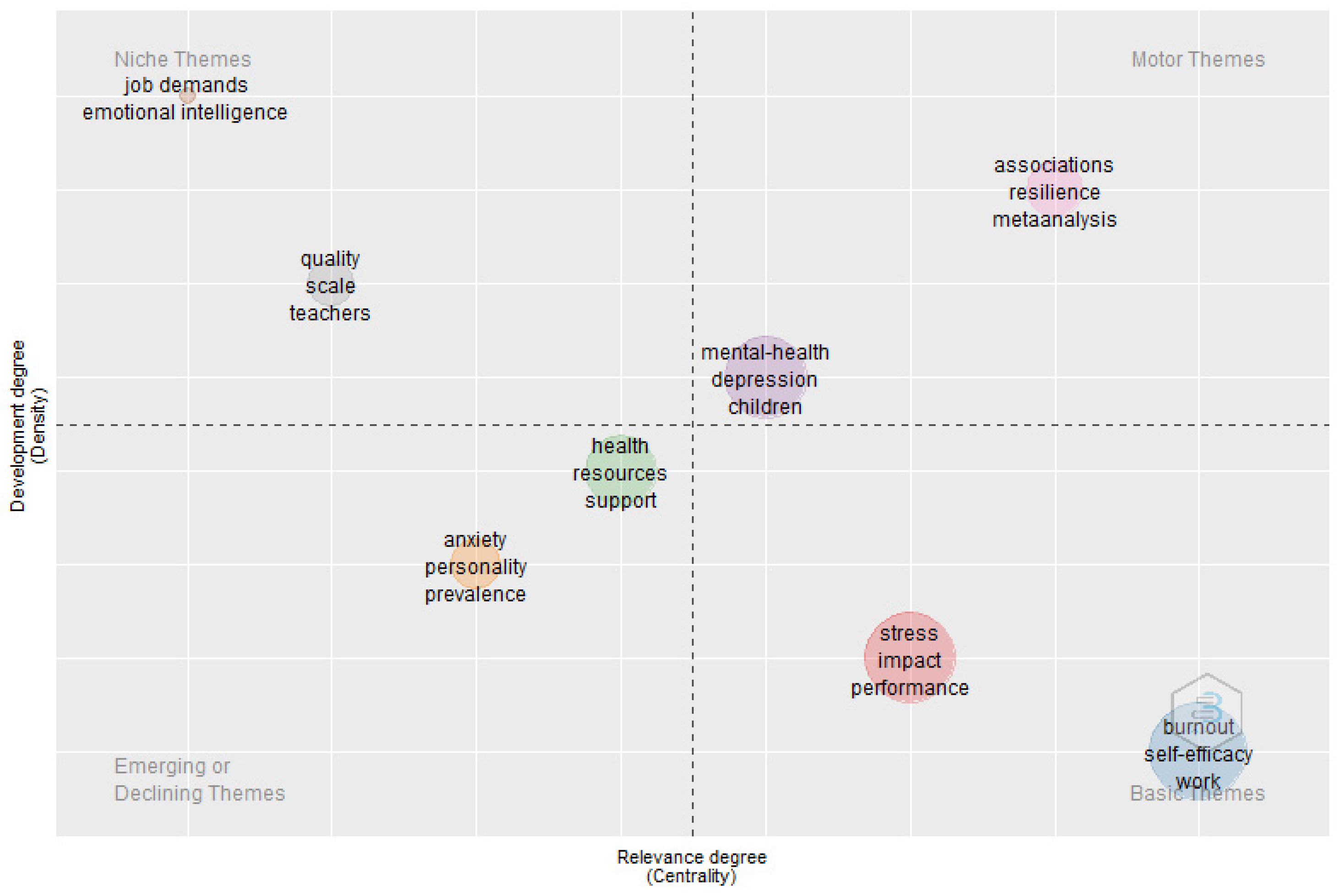
| Main Information about Data | |
|---|---|
| Journals | 33 |
| Articles | 75 |
| Average citations per documents | 4.97 |
| Avarage citations per year per document | 1.99 |
| Avarage years from publication | 1.16 |
| References | 3947 |
| Document Types | |
| Article | 75 |
| Documents contents | |
| Keywords Plus (ID) | 212 |
| Author’s Keywords (DE) | 264 |
| Authors | |
| Authors | 307 |
| Authors Appearances | 332 |
| Authors of single-authored documents | 5 |
| Authors of multi-authored documents | 302 |
| Authors collaborations | |
| Single-authored documents | 5 |
| Documents per Author | 0.24 |
| Authors per Document | 4.09 |
| Co-Authors per Documents | 4.43 |
| Collaboration Index | 4.31 |
| Author | Area of Training/Department |
|---|---|
| Lee J | Psychiatry |
| Liu F | Educational Science Teacher Education |
| Mondragon NI | Evolutionary and Educational Psychology Social Psychology |
| Ozamiz-Etxebarria N | Developmental and Educational Psychology |
| Pressley T | Psychology |
| Santamaria MD | Research and Diagnostic Methods in Education |
| Santxo NB | Didactics and School Organisation |
| Journal | Recs | TLCS | TGCS | JCR (2021) |
|---|---|---|---|---|
| Frontiers in Psychology | 14 | 0 | 53 | 2990 |
| International Journal of Environmental Research and Public Health | 13 | 0 | 89 | 3390 |
| School Psychology | 8 | 0 | 1 | 4333 |
| Frontiers in Psychiatry | 4 | 0 | 3 | 4157 |
| School Psychology Review | 4 | 1 | 10 | 2722 |
| Aera Open | 2 | 0 | 12 | 2280 |
| Bmc Public Health | 2 | 0 | 4 | 3295 |
| British Journal of Educational Psychology | 2 | 11 | 45 | 3241 |
| Early Childhood Education Journal | 2 | 1 | 2 | 1771 |
| Education and Information Technologies | 2 | 1 | 3 | 2917 |
| Frontiers in Public Health | 2 | 0 | 19 | 3709 |
| Heliyon | 2 | 0 | 2 | 2850 |
| International Archives of Occupational and Environmental Health | 2 | 0 | 0 | 3015 |
Publisher’s Note: MDPI stays neutral with regard to jurisdictional claims in published maps and institutional affiliations. |
© 2022 by the authors. Licensee MDPI, Basel, Switzerland. This article is an open access article distributed under the terms and conditions of the Creative Commons Attribution (CC BY) license (https://creativecommons.org/licenses/by/4.0/).
Share and Cite
Gómez-Domínguez, V.; Navarro-Mateu, D.; Prado-Gascó, V.J.; Gómez-Domínguez, T. How Much Do We Care about Teacher Burnout during the Pandemic: A Bibliometric Review. Int. J. Environ. Res. Public Health 2022, 19, 7134. https://doi.org/10.3390/ijerph19127134
Gómez-Domínguez V, Navarro-Mateu D, Prado-Gascó VJ, Gómez-Domínguez T. How Much Do We Care about Teacher Burnout during the Pandemic: A Bibliometric Review. International Journal of Environmental Research and Public Health. 2022; 19(12):7134. https://doi.org/10.3390/ijerph19127134
Chicago/Turabian StyleGómez-Domínguez, Valentina, Diego Navarro-Mateu, Vicente Javier Prado-Gascó, and Teresa Gómez-Domínguez. 2022. "How Much Do We Care about Teacher Burnout during the Pandemic: A Bibliometric Review" International Journal of Environmental Research and Public Health 19, no. 12: 7134. https://doi.org/10.3390/ijerph19127134
APA StyleGómez-Domínguez, V., Navarro-Mateu, D., Prado-Gascó, V. J., & Gómez-Domínguez, T. (2022). How Much Do We Care about Teacher Burnout during the Pandemic: A Bibliometric Review. International Journal of Environmental Research and Public Health, 19(12), 7134. https://doi.org/10.3390/ijerph19127134








